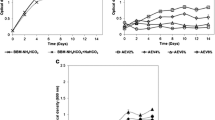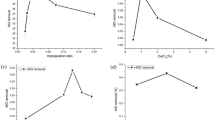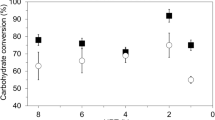Abstract
Speeding up the production of vinegar from rice wine by acetification, using a packed-bed bioreactor with a luffa sponge matrix (LSM) as adsorption carrier of acetic acid bacteria (AAB), and the effect of oxygenation of the recycled medium were investigated. The 0.06 L/min recycle of medium resulted in a high oxygen-transfer coefficient, while optimal dissolved oxygen (DO) of the medium maximized planktonic AAB cell growth with no contamination due to high acid in an external reservoir without LSM. The highest acetification rate (ETA) of 2.857 ± 0.1 g/L/day was achieved with DO 3.5–4.5 ppm at 35 ± 1 °C. To increase ETA, the optimized oxygenated medium was externally supplied and recycled at the ratio of 0.1. Therefore, acetification was conducted in both the bioreactor and reservoir resulting in an increased ETA (6 ± 0.2 g/L/day). This also aligned with the highest system AAB biomass (confirmed by scanning electron microscopy). Under the recycled oxygenated medium supply consistently high biotransformation yields (average 77.3%) were observed over nine sequential cycles. Meanwhile, an average ETA of 6.3 ± 0.2 g/L/day was obtained. This method can have practical applications in improving the efficiency and speeding up small-scale vinegar production.



Similar content being viewed by others
References
Azuma Y, Hosoyama A, Matsutani M et al (2009) Whole-genome analyses reveal genetic instability of Acetobacter pasteurianus. Nucleic Acids Res 37:5768–5783
Behera S, Ray RC (2012) Comparison of Luffa cylindrical L. sponge discs and Ca-alginate gel beads as immobilized matrices of Saccharomyces cerevisiae for bio-ethanol production from sugarcane molasses. Afr J Biotechnol 11:16172–16176
Chen Q, Shi Q, Gorb SN, Li Z (2014) A multiscale study on the structure and mechanical properties of the luffa sponge from Luffa cylindrica plant. J Biomech 47:1332–1339
de Ory I, Romero LE, Cantero D (2002) Optimum starting-up protocol of a pilot plant scale acetifier for vinegar production. J Food Eng 52:31–37
de Ory I, Romeo LE, Cantero D (2004) Optimization of immobilization conditions for vinegar production. Siran, wood chips and polyurethane foam as carriers for Acetobacter aceti. Process Biochem 39:547–555
Fregapane G, Rubio-Fernández H, Salvador MD (2001) Influence of fermentation temperature on semi-continuous acetification for wine vinegar production. Eur Food Res Technol 213:62–66
Fregapane G, Rubio-Fernández H, Salvador MD (2003) Continuous production of wine vinegar in bubble column reactors of up to 60-litre capacity. Eur Food Res Technol 216:63–67
Galacton AR, Cascaval D, Cãmãrut S (2010) Analysis of distribution of oxygen transfer rate in stirred bioreactors for yeast broths. Rom Biotechnol Lett 15:5423–5435
Gerchman Y, Schnitzer A, Gal R, Mirsky N, Chinkov N (2012) A simple rapid gas-chromatography flame-ionization-detector (GC-FID) method for the determination of ethanol from fermentation processes. Afr J Biotechnol 11:3612–3616
Hidalgo C, Vegas C, Mateo E et al (2010) Effect of barrel design and the inoculation of Acetobacter pasteurianus in wine vinegar production. Int J Food Microbiol 141:56–62
Horiuchi J, Tabata K, Kanno T, Kobayashi M (2000) Continuous acetic acid production by a packed bed bioreactor employing charcoal pellets derived from waste mushroom medium. J Biosci Biotechnol 89:126–130
Kocher GS, Dhillon HK (2013) Fermentative production of sugarcane vinegar by immobilized cells of Acetobacter aceti under packed bed conditions. Sugar Tech 15:71–76
Kocher GS, Kalra KL, Phutela RP (2006) Comparative production of sugarcane vinegar by different immobilization techniques. J Inst Brew 112:264–266
Krusong W, Tantratian S (2014) Acetification of rice wine by Acetobacter aceti using loofa sponge in a low-cost reciprocating shaker. J Appl Microbiol 117:1348–1357
Krusong W, Vichitraka A, Pornpakdeewattana S (2007) Luffa sponge as supporting material of Acetobacter aceti WK for corn vinegar production in semi-continuous process. KMITL Sci J 7:63–68
Krusong W, Petch-nom P, Pinviset P (2010) Semi-continuous production process of corn vinegar in stirred tank reactor using fixation of Acetobacter aceti WK on surface of loffa sponge. Kasetsart J (Nat Sci) 44:201–207
Krusong W, Pornpukdeewatana S, Kerdpiboon S, Tantratian S (2014) Prediction of influence of stepwise increment of initial acetic acid concentration in charging medium on acetification rate of semicontinuous process by artificial neural network. LWT Food Sci Technol 56:383–389
Krusong W, Yaiyen S, Pornpukdeewatana S (2015) Impact of high initial concentrations of acetic acid and ethanol on acetification rate in an internal Venturi injector bioreactor. J Appl Microbiol 118:629–640
Lasko DR, Zamboni N, Sauer U (2001) Bacterial response to acetate challenge: a comparison of tolerance among species. Appl Microbiol Biotechnol 54:243–247
Liu YK, Seki M, Tanaka H, Furusaki S (1998) Characterization of loofa (Luffa cylindrica) sponge as a carrier for plant cell immobilization. J Ferment Bioeng 85:416–421
Lotong N, Malaphan W, Boongorsrang A, Yongmanitchai W (1989) Production of vinegar by Acetobacter cells fixed on a rotating disc reactor. Appl Microbiol Biotechnol 32:27–31
Maestre O, Santos-Dueňas IM, Peinado R et al (2008) Changes in amino acid composition during wine vinegar production in a fully automatic pilot acetator. Process Biochem 43:803–807
Matsushita K, Inoue T, Theeragool G et al (2000) Acetic acid production in acetic acid bacteria leading to their death and survival. In: Yamada M (ed) Survival and death in bacteria. Research Signpost, Karala, pp 168–181
Ogbonna JC, Tomiyama S, Tanaka H (1996) Development of a method for immobilization of non-flocculating cells in loofa (Luffa cyclindrica) sponge. Process Biochem 31:737–744
Phisalaphong M, Budiraharjo R, Bangrak P, Mongkolkajit J, Limtong S (2007) Alginate-loofa as carrier matrix for ethanol production. J Biosci Bioeng 104:214–217
Qi Z, Yang H, Xia X et al (2013) A protocol for optimization vinegar fermentation according to the ratio of oxygen consumption versus acid yield. J Food Eng 116:304–309
Roble ND, Ogbonna JC, Tanaka H (2003a) A novel circulating loop bioreactor with cells immobilized in loofa (Luffa cylindrical) sponge for the bioconversion of raw cassava starch to ethanol. Appl Microbiol Biotechnol 60:671–678
Roble ND, Ogbonna JC, Tanaka H (2003b) L-lactic acid production from raw cassava starch in a circulating loop bioreactor with cells immobilized in loofa (Luffa cylindrical). Biotechnol Letter 25:1093–1098
Soo Park Y, Ohtake H, Fukaya M, Kawamura Y, Toda K (1989) Effects of dissolved oxygen and acetic acid concentrations on acetic acid production in continuous culture of Acetobacter aceti. J Ferment Bioeng 68:96–101
Stenstrom M (2007) Measurement of oxygen transfer in clean water. Standards ASCE/EWRI 2–06. 42pp. American Society of Civil Engineers, USA.
Toda K, Park YS, Asakura T, Cheng CY, Ohtake H (1989) High rate acetic acid production in a shallow flow bioreactor. Appl Microbiol Biotechnol 30:559–563
Torija JM, Mateo E, Guillamón JM, Mas A (2010) Design and optimization of TaqMan-MGB probes for the identification and quantification of acetic acid bacteria. Food Microbiol 27:257–265
Acknowledgements
This work was supported financially by the National Research Council of Thailand (Research No. 2560A11802138). The authors are grateful thank to not only Professor Salvatore Massa for his comment, but also Ms. Jutathip Phaungmala, Ms. Jutamas Pongampaiwong and Ms. Siriruk Amonchinwiwat for their laboratory assistances. The authors are especially grateful to Professor Anthony Keith Thompson, Visiting Professor at KMITL, Thailand, formally Professor at Cranfield University, UK and University of Asmara, Eritrea, for his internal edit of the revised manuscript.
Author information
Authors and Affiliations
Corresponding author
Ethics declarations
Conflict of interest
The author(s) declare that they have no conflict of interest to declare.
Rights and permissions
About this article
Cite this article
Krusong, W., Vichitraka, A., Sriphochanart, W. et al. Increasing the acetification rate of Acetobacter aceti adsorbed on luffa sponge using recycle of incremental oxygenated medium. 3 Biotech 10, 95 (2020). https://doi.org/10.1007/s13205-020-2093-x
Received:
Accepted:
Published:
DOI: https://doi.org/10.1007/s13205-020-2093-x




